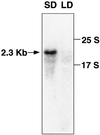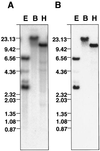Accumulation of a clock-regulated transcript during flower-inductive darkness in pharbitis nil
- PMID: 9536066
- PMCID: PMC35056
- DOI: 10.1104/pp.116.4.1479
Accumulation of a clock-regulated transcript during flower-inductive darkness in pharbitis nil
Abstract
To clarify the molecular basis of the photoperiodic induction of flowering in the short-day plant Pharbitis nil cv Violet, we examined changes in the level of mRNA in cotyledons during the flower-inductive photoperiod using the technique of differential display by the polymerase chain reaction. A transcript that accumulated during the inductive dark period was identified and a cDNA corresponding to the transcript, designated PnC401 (P. nil C401), was isolated. RNA-blot hybridization verified that levels of PnC401 mRNA fluctuated with a circadian rhythm, with maxima between 12 and 16 h after the beginning of the dark period) and minima of approximately 0. This oscillation continued even during an extended dark period but was damped under continuous light. Accumulation of PnC401 mRNA was reduced by a brief exposure to red light at the 8th h of the dark period (night-break treatment) or by exposure to far-red light at the end of the light period (end-of-day far-red treatment). These results suggest that fluctuations in levels of PnC401 mRNA are regulated by phytochrome(s) and a circadian clock and that they are associated with photoperiodic events that include induction of flowering.
Figures






Similar articles
-
Dark and Circadian Regulation of mRNA Accumulation in the Short-Day Plant Pharbitis nil.Plant Physiol. 1994 Feb;104(2):569-580. doi: 10.1104/pp.104.2.569. Plant Physiol. 1994. PMID: 12232107 Free PMC article.
-
Involvement of cyclic GMP in phytochrome-controlled flowering of Pharbitis nil.J Plant Physiol. 2008 May 26;165(8):858-67. doi: 10.1016/j.jplph.2007.02.010. Epub 2007 Oct 3. J Plant Physiol. 2008. PMID: 17913286
-
Transient increase in the level of mRNA for a germin-like protein in leaves of the short-day plant Pharbitis nil during the photoperiodic induction of flowering.Plant Cell Physiol. 1996 Sep;37(6):855-61. doi: 10.1093/oxfordjournals.pcp.a029022. Plant Cell Physiol. 1996. PMID: 8888623
-
Constitutive expression of the GIGANTEA ortholog affects circadian rhythms and suppresses one-shot induction of flowering in Pharbitis nil, a typical short-day plant.Plant Cell Physiol. 2011 Apr;52(4):638-50. doi: 10.1093/pcp/pcr023. Epub 2011 Mar 7. Plant Cell Physiol. 2011. PMID: 21382978
-
Time to flower: interplay between photoperiod and the circadian clock.J Exp Bot. 2015 Feb;66(3):719-30. doi: 10.1093/jxb/eru441. Epub 2014 Nov 4. J Exp Bot. 2015. PMID: 25371508 Review.
Cited by
-
Alternative transcript initiation and novel post-transcriptional processing of a leucine-rich repeat receptor-like protein kinase gene that responds to short-day photoperiodic floral induction in morning glory (Ipomoea nil).Plant Mol Biol. 2000 May;43(1):43-58. doi: 10.1023/a:1006408011873. Plant Mol Biol. 2000. PMID: 10949373
-
CRISPR/Cas9-mediated mutagenesis of the dihydroflavonol-4-reductase-B (DFR-B) locus in the Japanese morning glory Ipomoea (Pharbitis) nil.Sci Rep. 2017 Aug 30;7(1):10028. doi: 10.1038/s41598-017-10715-1. Sci Rep. 2017. PMID: 28855641 Free PMC article.
-
Suppression of the floral activator Hd3a is the principal cause of the night break effect in rice.Plant Cell. 2005 Dec;17(12):3326-36. doi: 10.1105/tpc.105.037028. Epub 2005 Nov 4. Plant Cell. 2005. PMID: 16272430 Free PMC article.
-
Isolation of a CONSTANS ortholog from Pharbitis nil and its role in flowering.Plant Physiol. 2001 Apr;125(4):1821-30. doi: 10.1104/pp.125.4.1821. Plant Physiol. 2001. PMID: 11299362 Free PMC article.
References
-
- Altschul SF, Gish W, Miller W, Myers EW, Lipman DJ. Basic local alignment search tool. J Mol Biol. 1990;215:403–410. - PubMed
-
- Beator J, Kloppstech K. Significance of circadian gene expression in higher plants. Chronobiol Int. 1996;13:319–339. - PubMed
-
- Bernier G. The control of floral evocation and morphogenesis. Annu Rev Plant Physiol Plant Mol Biol. 1988;39:175–219.
-
- Evans LT. Flower induction and the florigen concept. Annu Rev Plant Physiol. 1971;22:365–394.
LinkOut - more resources
Full Text Sources
Molecular Biology Databases

